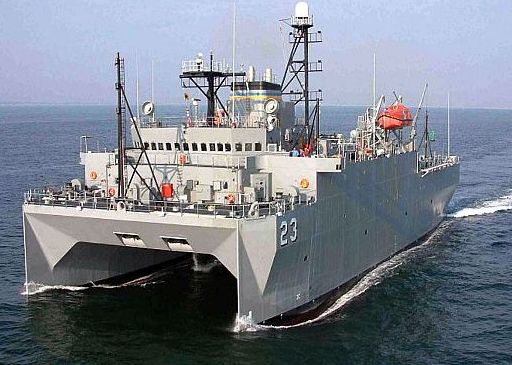During bilateral meetings on maritime safety, China asked the US to phase out surveillance activity using Low-Frequency Active Sonar near its coast. Over the past year, there have been five incidents in which Chinese ships (Naval and fishing boats) harassed the USNS Impeccable, one of two US ships equipped with LFAS, and other Navy ships. The Chinese object to surveillance activity within its EEZ (Exclusive Economic Zone), which extends 200 miles from each country’s coast; the US contends that such activity is only barred within the 12-mile territorial waters zone.

USNS Impeccable (US Navy photo)
Navy survey ships were harassed five times this year by Chinese naval and civilian vessels as well as military aircraft in the South China Sea and Yellow Sea – in one case 75 miles south of Hainan island, the location of a strategic Chinese Navy base which reportedly houses ballistic missile submarines. Beijing said at the time that the unarmed Impeccable, was carrying out “illegal surveying” in its EEZ, violating Chinese and international laws. The U.S. Navy says the Impeccable is designed to detect quiet foreign diesel and nuclear-powered submarines and to map the seabed for future antisubmarine warfare purposes.
The key bone of contention is that the Chinese do not accept that the Impeccable’s activities fall under recognized right of navigation in EEZ waters; the U.N. Convention on the Law of the Sea (UNCLOS) provides for “freedom of navigation and overflight” in EEZs. It says military activities inside EEZs must be “peaceful” and must not harm the coastal state’s environment or economic resources. The U.S., which has not ratified UNCLOS, argues that the treaty permits free navigation in EEZs, while China contends that surveillance activity does not fall into the “peaceful” category. (Ed. note: Definitions of peaceful aside—though “mapping the seafloor for future antisubmarine warfare purposes” hardly sounds peaceful—the environmental effects of LFAS within China’s EEZ are likely real, though not well understood. The US Navy has agreed not to use LFAS in or near US Marine Protected Areas; the main concern is that the intense low frequency sounds could injure very nearby animals, and, more likely, cause behavioral disturbances at greater distances, especially decreasing vocalization in large whales.)
The Chinese Defense Ministry said that “China believes the constant US military air and sea surveillance and survey operations in China’s exclusive economic zone led to military confrontations between the two sides. The way to resolve China-US maritime incidents is for the US to change its surveillance and survey operations policies against China. Decrease and eventually stop such operations.” Susan Stevenson, spokeswoman at the US Embassy in Beijing, says the US position has not changed, citing a statement made in July by US Undersecretary of Defense Michele Flournoy that said the US “exercises its freedom of navigation while putting emphasis on taking care to avoid any unwanted incidents”.
This post is drawn from press coverage by CNSNews, Reuters, and Bejing Review.
